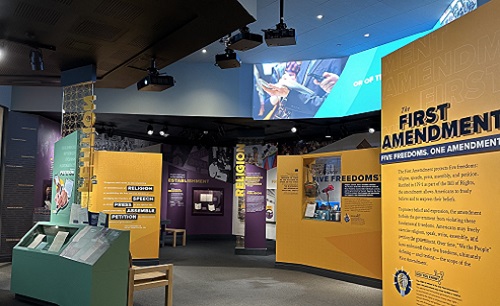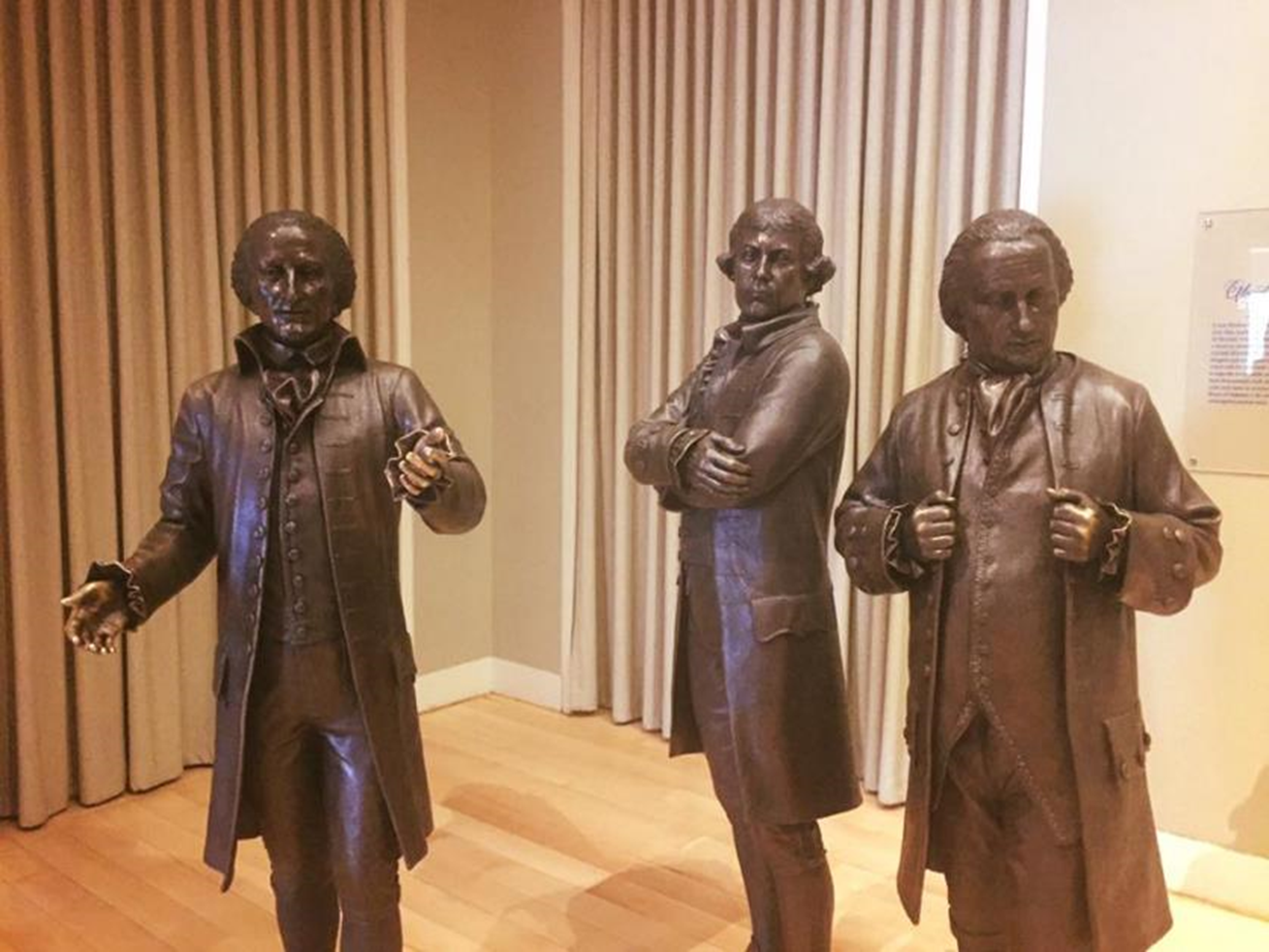
Constitution 101 Course
Start your constitutional learning journey


Shortly after the ratification of the U.S. Constitution, the Founding generation added the Bill of Rights—the Constitution’s first 10 amendments. These amendments guarantee many of our most cherished liberties, including the freedom of religion, the freedom of speech, the right to keep and bear arms, and the right to a jury trial. After the Constitutional Convention, the absence of a bill of rights emerged as a key part of the debates over ratification. Anti-Federalists—those who opposed the Constitution —pointed to the missing bill of rights as a fatal flaw in the new document. Several states ratified the Constitution with an understanding that amendments would be promptly added by the new government. This module will explore the origins of the Bill of Rights, explain its importance to the debate over the ratification of the U.S. Constitution, and walk through the specific rights enshrined in each of the first 10 amendments.
Purpose
Despite Benjamin Franklin’s closing speech calling for all delegates to unite in signing the new Constitution, the dissenters refused to sign it on September 17, 1787—the final day of the Constitutional Convention. They worried that the delegates had created a new national government with too much power. As part of this decision, they criticized the delegates for leaving out a bill of rights. This act of dissent was central to the later framing and ratification of the Bill of Rights. Think back to our earlier discussions about the Constitutional Convention in light of these objections. Do you think that you would have joined George Mason, Elbridge Gerry, and Edmund Randolph in dissenting?
Process
Think about the significance of the U.S. Constitution. Share the first idea or part of the Constitution that comes to mind.
Then, look at the Visual Info Brief: Three Delegates image of three delegates to the Constitutional Convention taken at the National Constitution Center’s Signers’ Hall Exhibit.

Answer the following questions and be prepared to engage in a classroom discussion:
Launch
Share the Visual Info Brief: Three Delegates image of three delegates to the Constitutional Convention taken at the National Constitution Center’s Signers’ Hall Exhibit.
Record student thoughts about the Constitution on the board. After a few minutes, recognize how many ideas, concepts, or rights are found in the Bill of Rights.
Ask students if they recognize these delegates (George Mason, Elbridge Gerry, and Edmund Randolph). If not, review delegate information in the Info Brief: Meet the Dissenters document. Share with the class and emphasize that these delegates are known as the “Dissenters.” Give some information about who they were, what states they represented, and their views of the Constitution.
Activity Synthesis
Quickly show the students the listing of rights in the Bill of Rights (short form ideas listing). Ask the students the following questions:
Activity Extension (optional)
Have students choose one of the Dissenters and learn more about him. Ask students to reflect on another moment when dissent has played an important role in American history, or in their own life.
Purpose
The First Congress formally approved the Bill of Rights on September 25, 1789, and sent it to the states for ratification. On December 15, 1791—so, over two years later—the first 10 amendments to the Constitution were ratified. In this activity, you will learn about the rights guaranteed by the Bill of Rights and the story behind its creation, including the key role played by the Dissenters at the Constitutional Convention.
Process
Watch the following video about the Bill of Rights.
Then, complete the Video Reflection: The Bill of Rights worksheet.
Identify any areas that are unclear to you or where you would like further explanation. Be prepared to discuss your answers in a group and to ask your teacher any remaining questions.
Launch
Give students time to watch the video and answer the questions.
Activity Synthesis
Have students share their responses in small groups and then discuss as a class.
Activity Extension (optional)
Now that students have a better understanding of the Bill of Rights, ask the following question:
Purpose
Before there was a national bill of rights, some of the states had drafted their own declarations of rights. In this activity, you will examine one of the most influential documents in the Founding era– the Virginia Declaration of Rights. Through studying the core rights enshrined in this historic document, you will highlight the similarities and differences between the Virginia Declaration of Rights and the Bill of Rights.
Process
Read the following documents:
Identify similarities and differences between the content of the documents.
Record the progression of ideas in the Primary Source and Activity Guide: Virginia Declaration of Rights and the Bill of Rights worksheet.
Launch
The goal is for the students to examine the Virginia Declaration of Rights and the core rights it protected and how these ideas manifested in the Bill of Rights. Ask students what is similar about the Virginia Declaration of Rights and the Bill of Rights and what is different between the two documents. Students can match up the text in the Virginia Declaration of Rights with the Bill of Rights and build a flashcard view (physically or digitally) of the Bill of Rights. One side is labeled “How it started” (Virginia Declaration of Rights) and the other side is “How it’s going” (Bill of Rights).
The Primary Source and Activity Guide: Virginia Declaration of Rights and the Bill of Rights worksheet will allow students to move sections of the Virginia Declaration of Rights to align with the Bill of Rights. Students can also find key sources from the Writing Rights interactive to add to the document.
Activity Synthesis
As a summary activity, play a game with students by reading a section of the Virginia Declaration of Rights out loud. Then have students buzz in to see who is first to answer the correct amendment connection in the Bill of Rights.
Activity Extension (optional)
Now that students have a better understanding of the origins of the Bill of Rights, encourage them to explore the Writing Rights interactive to examine other sources influencing the framing of the Bill of Rights. Ask them to choose another state’s bill of rights and use the Writing Rights Interactive to analyze its connection to the Bill of Rights in the U.S. Constitution.
Purpose
This activity aims to help students understand a surprising fact: The framers did not include a bill of rights in the original Constitution. Furthermore, some key founders even argued that a bill of rights was unnecessary and, possibly, dangerous. This activity will re-introduce students to two key founders, James Madison and James Wilson, and explore their critique of a federal bill of rights.
Process
In your group, brainstorm reasons why the delegates to the Constitutional Convention might have left out a bill of rights.
Then, brainstorm reasons why members of the Founding generation may have believed that it was not necessary to include the Bill of Rights in the Constitution. Why could it have been dangerous?
Read the three documents below and list key arguments for and against adding a bill of rights. Date each argument to show the transition from opposition to support.
Launch
Review the delegates that were at the Constitutional Convention, especially James Madison and James Wilson. Assign students to groups to complete the activity.
Activity Synthesis
Ask the following questions and follow up as necessary on students’ findings:
Activity Extension (optional)
Encourage students to reference their ratification timeline from Module 4 and look for any turning point connections.
Inform students that following the pivotal Massachusetts ratification convention, many leading Federalists compromised with their opponents and agreed to add new amendments to the Constitution once it was ratified. This cleared the way for the Bill of Rights. Madison was influenced by his friend, Thomas Jefferson, who was serving America in Paris and who strongly supported a bill of rights.
Purpose
In this activity, you will explore the big ideas for each of the 10 amendments in the Bill of Rights.
Process
Read the text of your assigned amendment and complete the task in the Activity Guide: Big Ideas of the Bill of Rights document.
Launch
Assign each student/group one of the first 10 amendments to the Constitution.
Students are encouraged to research information on the National Constitution Center website—especially the Interactive Constitution Common Interpretation essay on their assigned amendment.
Activity Synthesis
Have students/groups share their big ideas and visual representation with the class. This may be shared digitally or image collages may be added around the room for a gallery or story walk.
Activity Extension (optional)
Now that students have a better understanding of one of the amendments in the Bill of Rights, ask them to read about the Matters of Debate essays for that amendment on The Constitution webpage.
Purpose
As ratified, the Bill of Rights only applied to abuses by the national government—not the states. However, following the ratification of the 14th Amendment and later decisions by the Supreme Court, the Bill of Rights became a charter of national freedom—applying key Bill of Rights protections (like free speech and religious liberty) to abuses by all levels of government: national, state, and local. This process is known as incorporation. Today, virtually all of the key protections enshrined in the Bill of Rights apply with equal vigor against all levels of government.
In this activity, you will explore the relationship between the Bill of Rights and the 14th Amendment and study the process of incorporation.
Process
Read and interpret the language from Section 1 of the 14th Amendment then review the Info Brief: Incorporation.
“No State shall make or enforce any law which shall abridge the privileges or immunities of citizens of the United States; nor shall any State deprive any person of life, liberty, or property, without due process of law.”
Then, read and take notes on the following essays:
After you have finished reading these essays, identify the relationship between the Bill of Rights and the 14th Amendment. Describe how the 14th Amendment transformed the Bill of Rights.
Record your answers and be prepared to engage in classroom discussion.
Launch
Ask the class to list the most important Supreme Court cases of the last century. Take the list and circle each one that is a 14th Amendment case.
If students are having trouble naming cases, read from the Supreme Court case list and see if they recognize any names.
Activity Synthesis
Choose 2-3 cases to review as a group and ask if these cases involve the 14th Amendment or are solely about the Bill of Rights. Are these cases about the national government infringing on people’s fundamental rights found in the Bill of Rights or are they cases where the states are infringing on people’s rights?
Purpose
Congratulations for completing the activities in this module! Now it’s time to apply what you have learned about the basic ideas and concepts covered.
Process
Complete the questions in the following quiz to test your knowledge.
Launch
This activity will help students determine their overall understanding of module concepts. It is recommended that questions are completed electronically so immediate feedback is provided, but a downloadable copy of the questions (with answer key) is also available.
When crafting the Constitution, one of the central concerns of the Founding generation was how best to control government power. With the new Constitution, the Framers looked to strike an important balance—creating a new national government that was more powerful than the one that came before it while still protecting the American people’s most cherished liberties. They settled on a national government with defined but limited powers. Instead of placing authority in the hands of a single person (like a king), a small group of people (like an aristocracy), or eve...


Explore our new 15-unit core curriculum with educational videos, primary texts, and more.

Search and browse videos, podcasts, and blog posts on constitutional topics.

Discover primary texts and historical documents that span American history and have shaped the American constitutional tradition.